 Photo by David B. Gleason, CC BY-SA 2.0
Photo by David B. Gleason, CC BY-SA 2.0
The Pentagon Refuses to Disclose the Size of the Nuclear Arsenal – Where Is This Coming From?
Last week, the Pentagon revealed its decision not to disclose the 2018 US nuclear stockpile number. The announcement came from the Department of Energy, in response to a letter from the Federation of American Scientists.
This decision isn’t in any way beneficial to the US’ interests. Instead, it’s counter-productive. For starters, it incentivizes other states’ secrecy. By choosing to keep its nuclear capabilities a secret, the US is implicitly condoning a covert and enigmatic approach to nuclear security. That is contradictory to say the least, since the Trump administration is constantly insisting that Russia and China should be more open about their respective nuclear programs.
Next year, the United Nations Office for Disarmament Affairs will hold the Non-Proliferation Treaty Review Conference. One of the points to be discussed concerns Article VI of the NPT, namely the section establishing that the signatory states must work for the pursuit of nuclear disarmament. If the US refuses to disclose how many and what kind of nuclear weapons constitute its arsenal, it’ll simply be incapable of reporting its progress on reduction to the rest of the members.
In the over seventy years the world has known nuclear weapons, there hasn’t been a nuclear war. The main reason for this is nuclear deterrence. The entire concept of nuclear deterrence is based on the idea of transparency: if country A knows what country B has, A will feel safe in knowing its own capabilities are sufficient to discourage B from any aggressions. By taking the transparency factor out of the equation, what’s left is a situation where there’s plenty of space for doubts and assumptions. In other words, we lose the element of stability which, for all these years, has ensured we haven’t experienced a nuclear escalation.
How, then, should we interpret the Pentagon’s decision? In May 2010, the Obama administration declassified for the very first time the entire history of the American nuclear arsenal. Four years later, it even disclosed the precise number of retired warheads that, at the time, were still awaiting dismantlement. Could President Trump merely be trying to nullify the previous policy, regardless of its effectiveness, for the sole purpose of undoing his predecessor’s work? Needless to say, if that’s the case, it’s a poor example to set for the cause of international nuclear security.
But there also could be an even more unsavory reason for this secrecy. The current administration might have decided it wants to build more nuclear weapons – more tactical nuclear weapons, to be more precise. To this day, there isn’t any legally binding agreement setting a limit to the US’ nonstrategic nuclear capabilities, just like there isn’t any deal which allows the inspection of a country’s tactical forces – all inspections are limited to strategic systems. Well aware that an enlargement of its stockpile would be clashing with the declared intent to contribute to the world’s nuclear disarmament, though, the US might be trying to keep its program disclosed.
The Congressional Budget Office’s report describing the projected costs of US nuclear forces accounts for a $15 billion spending for tactical nuclear weapons and delivery systems over the next ten years. We can’t exclude a possible declaration from President Trump that considering the strong imbalance between the US’ and Russia’s nonstrategic nuclear capabilities, the US needs to develop new tactical weapons in order to ensure national security. Put in that way, the public audience might even overlook the whole “secrecy” element. Policymakers should hold the reins tightly on this budget.
It’s in the US’ strategic interest to maintain an open attitude when it comes to its nuclear capabilities. By denying full transparency about its nuclear stockpile, the US is implementing a strategy based on secrecy and mistrust―precisely at a time when it’s pressuring countries like North Korea to fully disclose their arsenals. This will inevitably alienate America’s allies, and worsen the relationships with countries such as Russia and China.
We are dealing with weapons which, if ever used, could end the world as we know it. Whatever new strategy the current administration is considering, it’s much wiser to undertake efforts aimed at preventing a nuclear arms race.





